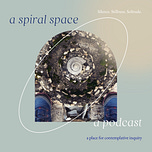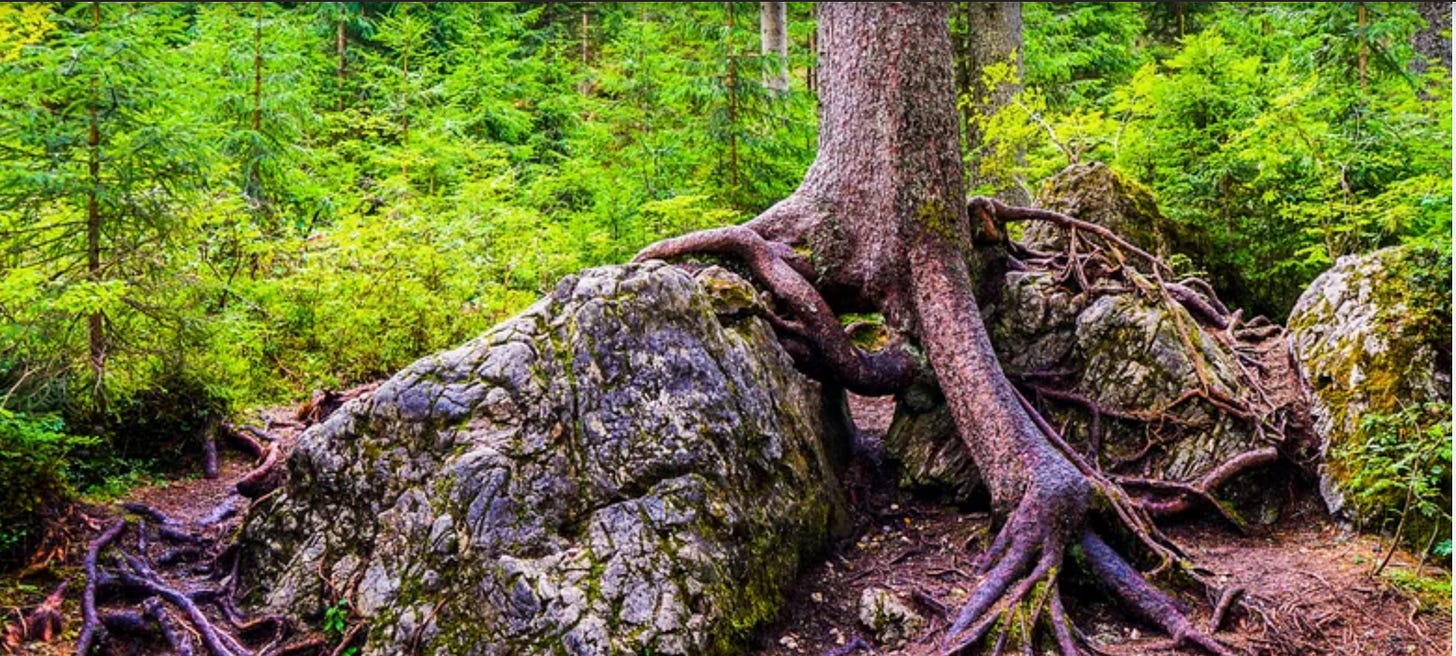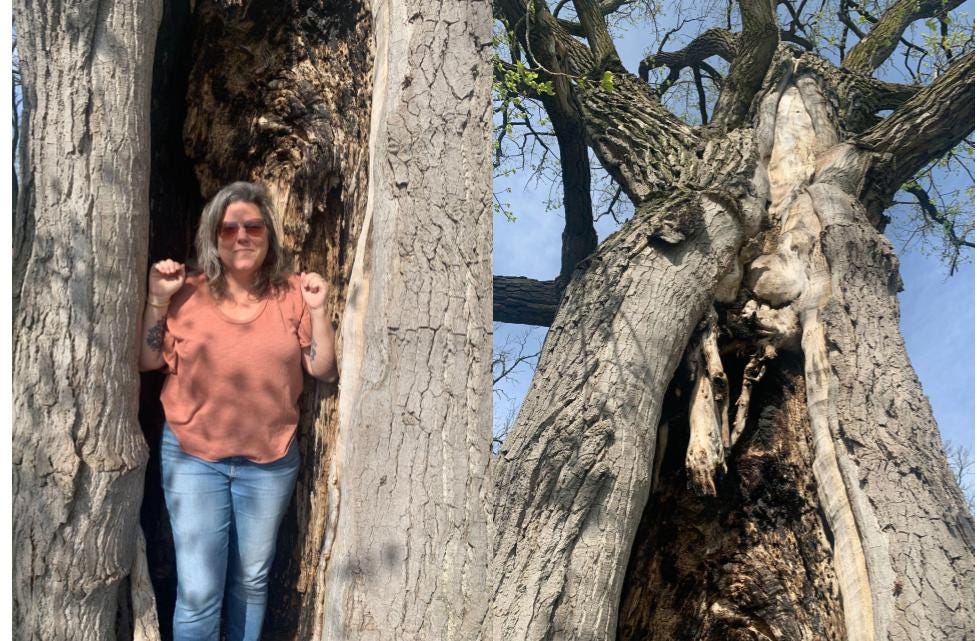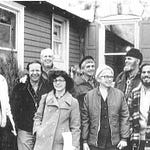Welcome to your random dose of digital Spiritual Direction, or what I like to call “therapy for your God baggage.” There’s two sections here, a podcast on prayer and a reflection that pairs with the pod. Pick and choose, read or listen in any order. Thanks for being part of the conversation.
🌿 🌿 🌿 🌿 🌿 🌿 🌿 🌿 🌿 🌿 🌿
I’ve stumbled onto two essays in the last month that reference a line in T.S. Elliot’s poem Ash Wednesday, “teach us to care and not to care.”
I wrote about the first essay by Eugene Peterson for my podcast, A Prayer Practice. You can check it out above.
The second essay was written by Dr. Belden Lane, retired theology professor at St. Louis University and my new obsession. My friend Adam Baker introduced me to Lane in a conversation on regular, everyday people who lean deeply into the practices of the saints and mystics. Lane is not necessarily a regular, everyday person - he has an incredible brilliance and deep humility. He’s a real life Lorax, speaking to and for the trees.
His work centers on the theology of place, a kind of eco-spirituality. Of the many books he’s written, I’m working my way through A Solace of Fierce Landscapes and Backpacking with the Saints. Landscapes is both a teaching around the spiritual significance of desert and mountain spaces as well as a memoir of Lane’s experiences in the final stages of his mother’s life with alzheimer's. It is a poignant juxtaposition. In Backpacks, Lane models the practice of sacred reading in the wilderness. Rumi in the high desert, St. Hildegard of Bingen in the wooded Ozarks, or Hafiz in the storied mountains of Wyoming. Both books are gold.
This past weekend I did an online retreat through St. Mark’s Episcopal church in Seattle. They hosted Belden as part of Earth Day celebrations. I could literally write for the next year about what I learned at this retreat. So many nuggets worth contemplating. Here are just a few:
“Beauty may be what initially brings us in, but shared suffering is what cements relationships.”
“Our longing is how God comes to us.”
“Tell me the place where you live and I’ll tell you who you are.” - Ortega y Gasset
“Tell me the place where you are drawn to and I’ll tell you who you are becoming.” - B. Lane
“A Tree when it dies, is only half way through its life.”
And probably the teaching that hummed for me the most was on Wilderness, Storytelling and the Power of Place which he divided into 4 Axioms of Place:
Sacred place is often an ordinary place, ritually set apart as extraordinary.
Simply moving into an allegedly sacred place doesn’t necessarily make one present to it. We need rituals of entry.
Sacred place isn’t chosen; it chooses you. A Holy place draws people to it.
Sacred place has a double impulse - to the local and the universal. It draws us into particularity and then sends us out to recognize that sacredness in everything. It is the point of pilgrimage.
Also on the sacredness of place:
A Trip to the Black Madonna
Poet, David Whyte at the Cliff's Edge
Chora: a place with its own energy, power, and sense of immediacy
I recognized the sacredness of place early, before I had even turned five years old. We moved to Connecticut when I was four and I went from midwest neighborhoods where sidewalks connected homes just feet from one another to living in the woods surrounded only by trees, rock outcroppings and a babbling brook.
I often set out for the woods by myself, picking blackberries and catching frogs. But my most sacred place was my honeysuckle fort that was outside the boundaries of our property across the street, which I doubt I was allowed to cross by myself. There I found the huge boulder at the edge of a prairie field covered by honeysuckle. I’d climb onto my “fort”and lay on top of it picking the lichen off its surface with my berry stained fingers as I basked in the sun inhaling the fragrance of the yellow flower.
I will always think of this place as the place I was happiest in the world, as the place where I had only the coolness of the breeze and the roughness of the rock to concern me. It is a place that transcends time and continues to teach me. It is the place my love for silence was born. It is the place that years later would remind me that silence is still my inheritance. It is the place that before I could even read, taught me most about the Holy, and it is the place that reminds me today to put down the books and go walk in the woods to encounter God.
What can you continue to learn from the sacred places of your childhood?
This feeling, Lane said, is Topophilia. “I found the land which matched my interior landscape. The door separating inside and outside opened. What my eyes saw meshed with images I carried inside my body. Pictures painted on the walls of my womb began to emerge.”
Like my honeysuckle fort, Belden has a sacred place across the street from his house in University City. It is an old tree, a Black Walnut that he calls Grandfather. He says that he’s entrusted the care of his soul to this tree. He visits the tree each night and even on one occasion was allowed by the city to hang a hammock high in the tree and sleep in Grandfather’s arms.
It lives in Heman park and before the Saturday section of the retreat, Bill and I went on a pilgrimage just a few miles from our home to visit Belden’s tree. It was an unusually windy day and the park was busy with youth baseball games and dog walkers. The street going by the park had the normal traffic of an urban neighborhood. And yet, there was Grandfather, whose heartwood has been hollowed out so that you could step right inside his great trunk; and when I did, the wind ceased, the noises quieted and time seemed to move slower and place transformed from topos, or a mere location, to chora, a place with its own energy, power and sense of immediacy.
I threw away the broken glass and few remnants of garbage that lay around Grandfather’s trunk and took a broken walnut shell to remember him.
What do you learn to ignore, and what do you learn to love?
In Eugene Peterson’s article, the “not caring” was about allowing and not always stepping in to fix people’s problems but rather to walk along side people in their suffering. To practice compassion.
In Brene Brown’s new series on HBO, Atlas of the Heart, Pema Chodron speaks about the practice of compassion. “Compassion is not a relationship between the healer and the wounded, it’s a relationship between equals. Only when we know our own darkness well, can we be present to the darkness in others. Compassion becomes real when we recognize our shared humanity.”
“Teach me to care and not to care” becomes a prayer for both boundaries as well as an ability to practice the kind of compassion that, true to its derivation, suffers with. As Lane said in the retreat, “it is shared suffering that cements relationships.”
Lane’s article on Caring and Not Caring, references the same line from Eliot’s poem but from a different perspective.
“I’m delighted to be back among the 400-year-old whitebark pine trees of the Wind River Range in northwest Wyoming. They stand as grand masters of sustained indifference.
This high desert country is a perfect place for reflecting on the hardy and compelling spirituality of the Desert Christians. These weathered saints, who served as an example for all who followed, knew the answers to the two great desert questions: what do you learn to ignore, and what do you learn to love?
I’ve come here to be reminded of the indifference I need to exercise in my life—and the indifference I need to resist. On the one hand, I tend to care entirely too much about others’ approval. I need to ignore it. On the other hand, when I’m not appreciated enough, I’m eaten by resentment and begin to turn inward—and a crippling indifference creeps up. The Desert Christians identified these two very different kinds of indifference as apatheia and acedia. They saw the one as an important virtue (trimming one’s life of trivial matters) and the other as the worst of the seven deadly sins (undercutting any possibility of love). So I’m here, as T. S. Eliot says, to learn both to care and not to care, to sort through the curious relationship between the practice of indifference and the freedom to love.”
-Belden Lane, Caring and not caring: The Desert Christians on apathy; The Christian Century, May 18, 2010
I deleted my facebook page last week. It was an exercise in fierce indifference. I find it almost impossible in this world of social media to practice apatheia as everything is geared towards triggering an irrational state of caring about the wrong things. When I find myself starting to care too much about views, the “like” button, or even just feeling too visible, I immediately start to feel the discomfort and negative indifference of acedia.
Maybe you too are finding the narrow path between apatheia and acedia difficult. Lane says we can learn a lot from the desert mothers and fathers and their commitment to living in a desert terrain.
“They went to the desert to learn not to care about what was unimportant, so as to begin to care about what really mattered. This practice of intentional apathy about inconsequential things proved an important antidote to the egocentric prosperity gospel of post-Constantinian Christianity.”
But what happens when acedia comes along? Lane says there’s a third way. “Agape is the freedom to love that which is made possible by the one [apatheia] and destroyed by the other [acedia]. A combination of extraordinary humility and deep insight into human frailty allowed the monks to readily identify the true self while ignoring the false self.”
This echos Chodron’s “Only when we know our own darkness well, can we be present to the darkness in others.” Maybe Lane and Peterson would add — and being present to the darkness in others is essential to loving them.
Richard Rohr says he prays everyday for a small humiliation. My pathway into humility is my sitting practice, a desert practice of sorts. When I start to fall into acedia, it is a sign that most likely my meditation practice has taken a back seat to other work that feeds my ego.
In fact this was just affirmed for me this morning when a friend described a Henri Nouwen book that outlines the pattern of Jesus’ time in wilderness. He starts with prayer alone, in the wilderness, connecting to God; then continues by connecting to community; then finally, he is ready to take action, which is at the core of Love. This is always the pattern from contemplation to action: the humility of wilderness, the wisdom of community, and the great love and mutuality of compassion.
As I look towards the summer and graduating from the Living School at the Center of Action and Contemplation in New Mexico and my first trip to the desert (!), I’m thinking about Lane’s Wilderness Spirituality: to practice silence, simplicity, to practice a fierce indifference to unimportant things, and finally, a reckless compassion that sends one right into the center of what it means to be human.















Share this post